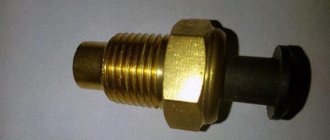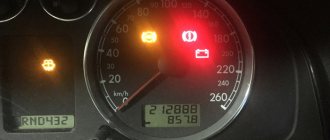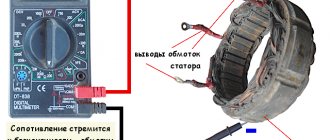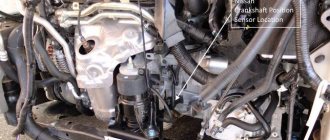A lambda probe is a sensor that evaluates the composition of exhaust gases while the vehicle is operating under different loads and speed conditions.
It transmits a signal to the main engine control unit, after which the composition of the fuel-air mixture is optimized. The lambda probe, or oxygen sensor (OS), is located in the exhaust gas system in front of the catalyst.
If there is a malfunction of the sensor or catalyst, or if the permissible performance standards are exceeded, the “check engine” light on the instrument panel lights up. It indicates that the engine needs to be diagnosed. In this case, the diagnostic result will display one of the three reasons listed above. For checking, special diagnostic scanners are used.
How it works?
What happens if you turn off the lambda probe? Before answering this question, you need to understand how it works. The main function is to control the operation of the catalyst
. More precisely, the purpose depends on the location of this sensor. The most common option is to install a probe in front of the catalyst. In this case, it controls the amount of oxygen in the mixture.
If necessary, it sends a signal to the control unit, forcing it to increase or decrease the amount of oxygen in the mixture. Also, a lambda probe is often installed after the catalyst. In this case, he checks the composition of the exhaust gases. If the level of toxic substances is high, a signal is sent to the control unit. As a result, the “check” lights up; computer diagnostics can indicate that the catalyst is faulty.
This sensor is called after the Greek letter? (lambda). This is how physics denotes the ratio of the volume of oxygen to the bulk of the fuel in the combustible mixture. The normal indicator is ?=14.7 per unit of fuel. If this indicator is lower or less, the sensor gives a command to the control unit to change the ratio.
Install the lambda probe decoy
A broken or malfunctioning DC cannot be repaired, but it can be replaced with an expensive new one or a fake one can be installed. Many car owners choose this simple method of deceiving the electronic control unit. In this case, the snag sends an average (similar to the working) signal to the ECU and the computer thinks that everything is fine. In this case, the whole point of engine adaptability is lost. The computer does not understand how well the mixture is prepared and how environmentally friendly the exhaust is. Without a normal sensor, the ECU goes crazy, which leads to increased fuel consumption and other troubles.
Types of decoys for a lambda probe
- Mechanical snag. This universal spare part is installed on almost all cars. There is a mini-catalyst inside it through which the exhaust gases pass. There they are cleaned a little and the electronic control unit receives lower emissions values.
- Electronic deception. It is specially programmed for a specific make, volume and year of manufacture of the car, which makes it more expensive than a mechanical one. The device is connected to the wires through which the values are adjusted to acceptable values.
In both cases, the signals from the first and second oxygen sensors will be different. The ECU will take these readings as normal operation of the catalyst.
Pros and cons of installing a lambda probe blende
The deception of the lambda probe will extinguish the "Check Engine". The cost, compared to other solutions, is small, so this is the most popular procedure.
The decoy does not take into account different parameters and operating conditions of the engine. For example, adjusting fuel injection. Therefore, during automatic correction, after some time the readings will go beyond the conventionally normal limits, error P0140 will appear again and the check will light up.
Disabling the catalyst
If the O2-sensor fails, begins to generate a permanent error, or has simply been removed mechanically, it makes sense to perform a software shutdown. It is carried out by reprogramming the engine control unit so that it can exclude from its algorithm the call to the converter for data on its current state. Disabling the oxygen sensor, done in this way, seems to be very beneficial:
● the motorist does not need to replace faulty lambda probes with working ones or snags;
● the procedure takes from 15 minutes to several hours (depending on the complexity of the control unit) and is inexpensive;
● as a result of such actions, the characteristics of the car are noticeably improved (the responsiveness of the gas pedal increases, the torque increases and the dynamics increase).
Disable lambda probe programmatically
After physically removing the catalyst, software shutdown of the lambda probes located after it is a mandatory step. Without adaptation, the DC located after the catalyst transmits incorrect emissions indicators, the check light comes on and the engine goes into emergency mode. This is fraught with increased fuel consumption and poor dynamics.
Disabling using chip tuning will bring pleasant bonuses:
- Power and torque indicators will increase;
- Fuel consumption will decrease (compared to emergency mode);
- Lower traction will improve;
- The gas pedal will become more responsive;
- The overall dynamics of the car will improve, acceleration will become faster;
- Gearbox shifts will be smoother;
- Engine operation is optimized with the air conditioning on, and the car will no longer be “stupid.”
Programmatic shutdown of lambda probes is carried out by ADACT partners in Russia and the CIS countries.
Disable lambda probe
What is a lambda probe in a car, what happens if you disconnect the oxygen sensor
Lambda probe (λ probe) is a special device, one of the types of sensor. The task is to control the volume of oxygen in the power unit manifold.
The device estimates the total volume of oxygen or unburnt fuel mixture in the vehicle exhaust.
Lambda probes are often installed in the chimneys of heating boilers and other systems where oxygen control is required.
The lambda value is 14.7 units per unit of fuel. Proportionality is ensured thanks to electronic injection of the fuel mixture and the operation of a lambda probe.
The purpose of the device also depends on its position in the vehicle.
As a rule, an oxygen sensor is mounted in front of the catalyst, which makes it possible to accurately measure the oxygen level in the combustible mixture, and in case of imbalance, give a signal to the injection control unit.
To increase operating efficiency, new car models are equipped with not one, but two sensors, attached to one and the other side of the catalyst.
This design allows for more accurate analysis of the exhaust composition.
Evolution of development
Previously, oxygen sensors were resistive, which reduced the accuracy of measurements and the reliability of the devices themselves.
A modern lambda probe works as a threshold device. In this case, the signal received from the sensor allows you to accurately record the level of oxygen ratio in the exhaust and correct it.
The optimal ratio is 14.7:1 (actual to required air volume). If the parameter λ corresponds to this standard, then the mixture is ideal.
If the indicator is exceeded, the mixture is lean. If λ , on the contrary, is smaller, then there is a lot of mixture in the exhaust and the volume of oxygen is not enough for combustion.
The lambda probe was first manufactured in 1960 by Robert Bosch GmbH. The project manager was Günther Baumann.
The device entered mass production only 16 years later (in 1976). The first manufacturers to start production were Saab and Volvo.
Main device types
Today there are several types of oxygen sensors. All of them may differ according to several criteria:
- by number of wires - from 1 to 6;
- on the organization of the sensory element (there are two types - plate and finger);
- for fasteners in the exhaust pipe - flanged or threaded;
- according to the measurement range of the lambda parameter - broadband (measurement is made in the range from 0.7 to 1.6 ) or narrowband, controlling the lambda level at a level above unity.
Each type of device has its own characteristics.
One contact devices.
Equipped with one signal wire. It is through it that the signal generated by the device is transmitted.
2-pin sensors.
Equipped with two wires. One is a signal, and the second performs the function of grounding through the device body.
Using the grounding conductor, you can accurately determine the performance of the signal wire.
3-pin.
There is a signal wire, one ground wire and a third wire going to the heating device.
The peculiarity of such sensors is the rapid achievement of the desired temperature, an increased service life of the device, as well as lower requirements for the exhaust system.
The heating element, which is mounted in the system, has a power of 12 or 18 W.
4-pin devices.
They have four wires:
- signal conductor,
- the wire,
- feeding the heating device;
- the third wire is “ground”;
- fourth wire - can be used to solve any other problems (depending on the vehicle control system).
This may be the position of the contacts.
For example, it can be used as grounding or to power a heating element.
The peculiarity of modern lambda probes is that they are interchangeable and have a similar design.
For example, you can replace heated sensors with non-heated ones. In this case, there may be problems with the connectors or the inability to power the device.
If there are not enough wires, you can lay them yourself and use the car contacts as a connector.
The markings may vary, but the signal wire is always painted black.
The "mass" may be yellow, gray or white.
The design of modern oxygen sensors
The oxygen sensor has two electrodes - internal and external.
The first is made of zirconium, and the second is made of platinum coating, which makes it more sensitive to oxygen.
The lambda probe is mounted in such a way that it passes the entire volume of exhaust gases of the vehicle.
As gases pass through, the external electrode evaluates the oxygen level in the exhaust gases, which leads to a change in the potential between the electrodes.
The greater the volume of oxygen, the higher the voltage level. The operating temperature of the zirconium with which the electrode is coated is 300-1000 degrees Celsius.
That is why oxygen sensors are structurally complemented by heaters, which are necessary at the time of start-up.
There are two types of sensors - point-to-point and wideband. They are similar in appearance, but differ in design and principle of operation.
Thus, a 2-point sensor consists of two electrodes. Its task is to fix the coefficient of increased air volume in the fuel mixture.
As for the broadband device, this is a more modern design. its peculiarity is the use of pumping current.
In this case, the design of the broadband sensor consists of two ceramic devices - a pumping device and a 2-point one.
Operating principle
Oxygen contains negatively charged ions. They are assembled on platinum electrodes and when the desired sensor temperature is reached (about 400 degrees Celsius), a potential difference (voltage) is created.
If the mixture is too lean, then the volume of oxygen in the gases will be high, and vice versa, if the mixture is rich, then there will be little oxygen.
In the first case, the voltage is 0.2-0.3 Volts, and in the second - 0.7-0.9 Volts.
The motor control system maintains a voltage level of about 0.4-0.6 Volts, that is, the lambda level is 1.0 .
During movement, the operating modes of the motor change, which helps to adjust the voltage parameter in both directions. In this case, a narrowband sensor can only capture those parameters that are above zero.
Diagnostics
Often, completely different failures are mistaken for a lambda probe failure. Therefore, before purchasing a new sensor (it costs a lot), you should definitely carry out diagnostics. The best option is to use a diagnostic scanner. The computer usually shows if there is a lambda probe error. In some cases, there is a complex of problems; in addition to the oxygen sensor, some other parts of the car also fail.
There is also a “collective farm” diagnostic method. It consists of turning off the sensor and checking how the car will work without it. It is believed that if the probe is in working order, its disconnection will lead to deterioration in engine performance or the inability to start it. If the sensor is faulty, there will be no changes. Unfortunately, this diagnostic method is not always reliable; it is better to carry out computer diagnostics.
• Guaranteed failure of the catalyst and the 2nd lambda probe if you continue to drive with a faulty 1st lambda probe.
• Deterioration of cold engine starts, uncomfortable driving, accompanied by reduced power and floating idle speed and sometimes dips at speed from 2000 to 3000.
• Increased fuel consumption, on average by 5-20% of normal and even up to 50% in severe cases, which ultimately will result in the cost of a new lambda probe over the course of a year.
• A check engine light that simply adds worry to your life and behind which you can see another problem.
If any malfunction of a modern car appears, it is necessary to hasten to eliminate it, preferably refusing further intensive use until it is eliminated. More than any other part, this applies to the lambda probe. As is already known from the article “What is a lambda probe for?”, this sensor, together with the catalyst, is responsible for the purity of exhaust gases from harmful impurities. It sounds quite innocent, and many car enthusiasts believe that after the oxygen sensor fails, all that threatens them is an increase in harmful impurities in the exhaust system. However, this is not the case.
Drivers, let's try to figure out what happens to the engine and its systems when you continue to operate a car with a faulty oxygen sensor, using the example of two main threats.
Reducing engine life. Briefly about the mechanism of this process, which develops in two directions.
As a result of a malfunction of the sensor or its incorrect operation under the influence of external factors, an over-enriched fuel mixture may be supplied to the cylinders. This mixture does not burn completely, as a result of which the electrodes and insulators of the spark plugs and combustion chambers become covered with black soot. Heavy carbon deposits coke the cylinder compression rings. An incomplete fit and a decrease in compression occurs, as a result of which some of the gases enter the crankcase and “poison” the oil.
But this is not as dangerous as the process that runs parallel to the one described above. The remains of unburned fuel that has penetrated the compression rings wash away the oil film from the surface of the cylinder, causing dry friction, leading to a reduction in its service life, and in advanced cases, to overheating of the engine.
Failure of the catalyst and the 2nd lambda probe. As we have already found out, exhaust gases with remaining fuel enter the exhaust pipe. As a result, the catalyst begins to work in emergency mode, burning out the remaining fuel. Gradually the catalyst is destroyed, the products of its destruction begin to clog its honeycombs. The catalyst begins to overheat and melts, finally sealing its entire honeycomb structure. As a result, the engine power finally drops and the car stops driving due to the fact that there is no room for free exhaust gases. During this process, the 2nd lambda probe is also poisoned.
Types of sensors
All probes are completely identical in principle of operation. All the differences lie in the features of the power supply connection. In practice, they are usually distinguished by the number of wires that are connected to the probe. The most common are two- and three-pin sensors. There are also options with and without heating. Heated sensors are more effective when starting the engine in winter, they show better results.
If necessary, both types of probes are interchangeable. You can also install a sensor from any car, even with a different number of wires. Only in this case will you have to tinker with the connection.
Stories of car owners
Since the lambda probe is a rather “insidious” sensor, many problems can be associated with it. Often, with increased fuel consumption, car owners believe that the reason lies precisely in the pressure factor. Below are three stories from car owners that clearly demonstrate the problems and their solutions.
Story No. 1.
Alexey, a car forum user from Rostov, owns a Mazda 3 with a 2.0 liter engine. He had a problem with increased fuel consumption. Even in a quiet mode of movement, the car spent 15 liters per hundred kilometers. There was also an error “check” on the dashboard, indicating a malfunction of the lambda probe, as the driver believed. A new sensor for his car costs from 10 thousand rubles, and Alexey was not ready to spend that kind of money. There was an option to purchase an analogue part of the BOSCH brand costing 3 thousand rubles, but it might not fit the car due to resistance. Therefore, the car owner began to look for other methods to solve the problem. He remembered that a month and a half ago he started filling up his car at a Lukoil gas station, after which the check light came on. A friend advised me to add an additive to the tank that increases the octane number of gasoline. But the store dissuaded the car owner from doing this, because there is a high risk of burning the valves. But Alexey was advised to purchase a cleaning additive, which is also poured into the tank. He also checked the oil level and added it to the proper level. Alexey filled the gasoline at another gas station, after which he added the additive. Fuel consumption dropped to 9.5 liters, and the check went out. We can conclude that the error may also occur due to low-quality gasoline, and not only due to malfunctions of the exhaust system.
Story No. 2.
The second story was told by Sergei, who bought a 1989 Opel Vectra A from his own hands. Fuel consumption was too high and reached 12 liters per 100 km. Since the Check engine light was on, it was decided to carry out diagnostics. It showed a faulty lambda probe. Sergei replaced the oxygen sensor, this helped, but only for two weeks. After this, the sensor became unusable again, and the “check” light came on. The car owner installed a used one so as not to spend a lot of money. This also solved the problem for a short time. Sergey began to look for more detailed information and found out that previously a different type of engine was installed on the Vectra A, and just starting in 1989, new engines were introduced. Structurally, they were no different, but in older engines a lambda probe was not provided, and different firmware was used. By reflashing the problem, the problem was eliminated, because the control unit now considered the CD non-existent.
Story No. 3.
Automotive forum user Taylor from Krasnodar complained about the high fuel consumption of a VAZ car. He decided to change the lambda probe, thinking that this would help. But in the end, he was unable to disconnect it, and the car enthusiast continued to drive with the sensor disabled. Naturally, the problem was not solved, although consumption decreased somewhat. The situation was successfully resolved when the person went to a car service center, where a new part was installed.
Clean the lambda probe
Often soot accumulates on the oxygen sensor, and combustion products settle inside. This prevents him from working at full capacity. The car loses traction, the maximum speed decreases and fuel consumption increases. One solution to the problem is cleaning the lambda probe.
How to clean the oxygen sensor:
- Before cleaning the probe, inspect it carefully. If there is damage or the structure is deformed, then the malfunction is unlikely to be related to contamination. If there is no damage, you can clean it.
- You will need orthophosphoric acid, which effectively corrodes scale and removes soot. Do not use mechanical cleaning tools: iron brush, sandpaper, needle file, etc. You will damage the precious metal layer and the sensor will become unusable. Remove the oxygen sensor from the car and place it in acid. To speed up the process, take a soft brush and apply the liquid evenly over the entire surface.
- Phosphoric acid cleans the lambda probe in 15–25 minutes. Afterwards, rinse the device with warm water and dry thoroughly.
Unfortunately, cleaning does not always help.
If orthophosphorus baths do not bring results, the oxygen sensor should be replaced or disabled by software.











